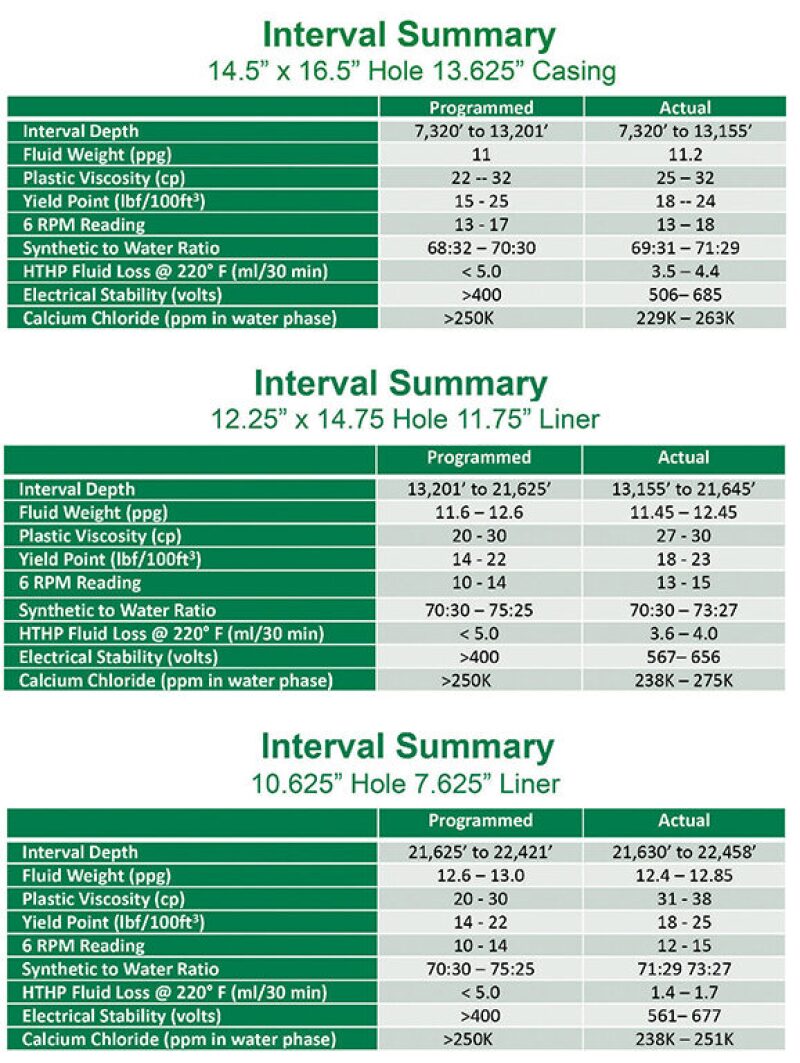While drilling in deepwater Gulf of Mexico, a topdrive failure forced the shutdown of all drilling operations for the rig operator and lasted for 114 hours (almost 5 days). At the time of the failure, the equivalent static density (ESD) was 11.36 ppg and the equivalent circulating density (ECD) was 11.5 ppg. The rate of penetration (ROP) was 100 ft/hr.
Troubleshooting
It was recommended that there be no utilization of the pumps while drilling was stopped, to reduce the chance of packing off the annulus with cuttings until the rotating and reciprocating could continue. During this time, a 100‑psi backpressure was maintained using the managed-pressure drilling system. Kronos low-ECD synthetic-based mud (SBM) at a weight of 10.9 ppg was utilized during this event.
During troubleshooting and repair work, a 1,500-bbl 11.4-ppg riser cap was spotted. Following the repair of the topdrive, a malfunctioning packer had to be replaced, causing additional delays.
After the packer was set and the blowout preventers tested, the 11.4 ppg riser cap was displaced and subsequently replaced with 10.9-ppg low-ECD mud. The Kronos system was designed and maintained to have adequate suspension properties to maintain wellbore integrity without sag during unexpected downtime, even with cuttings left in the hole. The rig continued to trip into the hole to 9,800 ft. At that time, a bottom-up was circulated and a maximum of 575 units of gas was circulated out.
Drilling then continued using a base oil and premix for dilution. The lost circulation material in the background continued to be blended into the dilution products being used at the time. During the drilling from 11,636 to 12,845 ft, the decision was made to increase the mud weight to 11.15 ppg.
When the drilling continued from 12,845 to 13,234 ft, formation water was detected from the mud check entering the mud system.
The system was treated to minimize the damage caused by formation water and maintain the properties sought by the operator. To assist in maintaining the desired weight and to prevent low-gravity solids from impacting the mud weight, two shakers were screened up to API Standard 120. At roughly the same time, the mud weight was increased to 11.2 ppg and then to 11.4 ppg.
While continuing to drill, one of the engines that provided power to the mud pumps broke down, reducing the flow rate required to clean the hole. A cement unit was added to the pump to replace much of the volume lost with the broken mud pump.
At 13,155 ft, the decision was made to call this current interval at total depth. The back-reaming process also started at that time. To assist with the hole cleaning, a high-viscosity sweep was blended and circulated. An additional high-viscosity sweep was blended and circulated, the second time at 9,058 ft.
With continued back reaming through some tight spots to 7,272 ft, operators decided to wash back down 7,938 ft and pump one more high-viscosity sweep. Once the hole was clean, a flow check was performed and operators began to pull out of the hole.
There were no sag events or torque-and-drag issues after all shutdown events. The Kronos SBM system remained static for 22 days throughout this interval. A total volume of 4,049 bbl of 10.5-ppg low-ECD SBM and 1,004 bbl of unweighted (premix) were initially ordered for this project; however, an additional 1,510 bbl of 11.5 ppg low-ECD SBM and 1,006 bbl of unweighted (premix) were ordered during the weight-up operations.
The rheology of the fluid was monitored and maintained for proper hole cleaning and barite suspension. The plastic viscosity, yield point, and gel strengths remained within specification during the interval and were measured at 150°F, 100°F, and 40°F to initiate monitoring of the Kronos flat rheology and low-ECD profile.
The alkalinities ranged from pH 2 to 3.4 with the addition of lime made while drilling. The calcium chloride (ppm in the water phase) was delivered at 229,000, but climbed to 263,000 with the addition of a calcium chloride product. The electrical stability of the fluid began at 211 V and was increased to 648 V with the additions of base oil and Kronos.

Results
The needed repairs to the topdrive resulted in 5 days with no circulation and the fluid remaining static. After 114 hours of being static, the rig was able to rotate and reciprocate. The pumps were ramped up and cuttings removed from open hole, which was 2,815 ft, with approximately 40 bbl of cuttings to remove while shut down.
Once circulating, the ESD was 11.28 ppg and the ECD was 11.33 ppg. The mud weight in and out was 10.9 ppg with one increase to 11.1 ppg observed at the shakers, approximately one quarter into the first bottom-up. This was the only increase in mud weight with no decreases while circulating. The mud weight maintained at 10.9 ppg with no sag indication while using the Kronos low-ECD SBM.
A total of three bottoms-up were observed before the hole was clean. No tight spots or torque increases were observed while pulling out of the hole.


